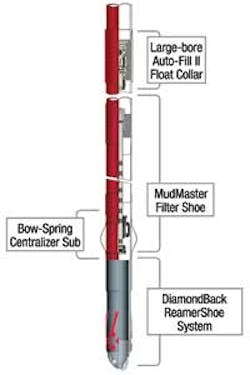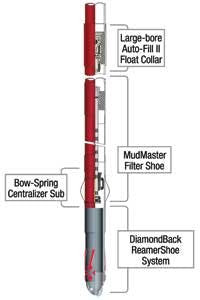p.2 ~ Well integrity initiatives improve deepwater well construction
View Article as Single page
The real-time monitoring and control afforded by the system allows the onshore operations team and offshore crew to collaborate during the tubular running job. Such collaboration can quickly identify potential connection problems while the operation is still going on, which minimizes the risk of leaks or damage to any connection.
Further efficiency improvements are realized by deploying services that allow for offline preparation of pipe prior to delivery to the rig, without compromising well integrity. By making up doubles or triples of pipe joints onshore, for example, operators realize efficiency gains and increased safety by reducing the amount of manual intervention required on the drill floor.
Reducing the surge
The integrity of the well may also be compromised while running casing through tight tolerances. Running the casing too quickly may not allow the wellbore pressure to be relieved quickly enough, resulting in a surge in the open hole that serves to damage the formation. Simulation models may be run to gauge the effective tripping speeds to minimize losses and reduce the surge pressures in the open hole. Further surge management is realized by running a diverter tool in conjunction with auto-fill float equipment to divert displaced fluids from the running string into the annulus. By quickly moving wellbore fluid out of the way of the descending casing string in this manner, tripping speeds can be increased with less risk of building up surge pressure and fracturing the formation.
To prevent buckling and reduce axial drag and friction while running casing, centralizer subassemblies may be deployed as part of the tripping operation. A centralizer sub keeps the casing string central to the wellbore while running, and new sub designs can contract to pass through tighter ID sections of the well. Regardless of whether one is rotating or reciprocating the casing string, the centralizer sub allows casing to reach its intended TD with less risk of damage that can shorten its operating life.
An operator needed to gain control of an ultra-deepwater well in the Black Sea to avoid formation damage, while minimizing rig time and mud losses. In response, Weatherford deployed its WellMaster system. For this well, the WellMaster solution consisted of a premium liner-top packer, WPHS liner hanger, an auto-fill collar, a filter shoe, a multiple-opening diverter tool, and rotating centralizer subs. This solution allowed the operator to run a liner to a total depth of 16,213 ft (4,942 m), while isolating a weak formation, eliminating a potentially costly problem and saving considerable rig time. A flawless cement job was performed at speeds of up to 45 ft/min (13.7 m/min)—with zero mud spills and zero recordable incidents.
Cementing integrity
There is more to ensuring a high-integrity cement job than just the cement. It also requires a combination of proper planning, reliable technology, and collaborative field operations that work toward successful execution. Planning begins with gaining a thorough understanding of the cementing challenges and objectives in deepwater wells.
Stage cementing is one option for deepwater wells that allows individual sections, or stages, of the well to be isolated and cemented independently. Annular casing packers are typically deployed in stage cementing applications. As their name implies, they are deployed down the annulus to their desired setting depth, and the packers are then inflated to close off the annulus below. Cement is then applied in that zoned-off section, but much less than would be required for a longer interval. As a result, the pressure exerted by the weight of cement against the wellbore wall is reduced.
Another cementing option gaining traction among deepwater operators and regulators alike is reverse cementing. Unlike conventional methods in which a great deal of pressure is applied downhole to move the cement up the annulus, reverse cementing pumps cement down the ID of the well to a certain point, whereupon the cement passes through a liner reverse cementing tool that diverts flow from the ID to the OD of the string.
The cement moves down the annulus to bottom. The displaced mud then comes back up the ID until it reaches the crossover tool and exits out to the annulus once again, but at a shallower depth and with a lower hydrostatic head above it. The mud then finishes its trip to surface up the annulus.
Reverse cementing allows the cement to freefall (in vertical wells) down the annulus to bottom, rather than requiring significant pumping pressure to pump the cement up the annulus and place greater pressure on the wellbore wall. In essence, reverse cementing may allow for a better cement job, but with less risk of formation damage and lost circulation.
The concept of well integrity, safely getting pipe in the ground and securely cemented in place, is relatively easy to explain but much more challenging to implement in the field. Ensuring that each step of well construction occurs seamlessly, and that adequate contingencies are in place to address a loss of wellbore control, requires a methodical and collaborative approach to well planning. Every party involved in well construction, from the operator to every service provider, must be willing to share their insight and learn from others if a high-integrity and profitable well is to be realized.

